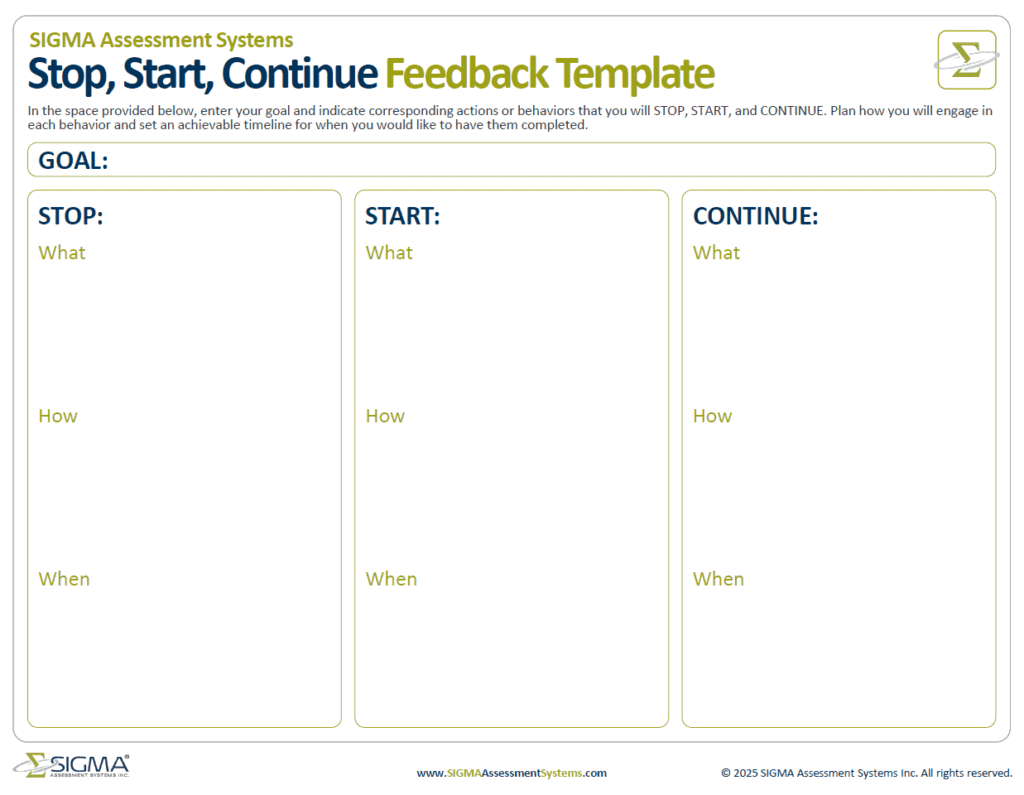How to Use the Stop, Start, Continue Method for Effective Feedback
The Stop, Start, Continue method is a simple but powerful framework for providing structured feedback. It helps improve performance, refine processes, and shape behaviors by focusing on what to stop, start, and continue doing. Widely used in performance reviews, team reflections, and personal development plans, this method drives meaningful improvements in both individual and team performance. Consider using the Stop, Start, Continue method in the following scenarios:
- When improving team performance as a new manager.
- To enhance communication across the organization.
- For boosting employee engagement and motivation in human resources (HR) initiatives.
- To optimize productivity and workflows as a team lead or operations manager.
How it Works
The Stop, Start, Continue method is popular because it is easy to implement and delivers impactful results. The framework is simple, making it scalable for individuals, teams, and organizations. To use the Stop, Start, Continue method, participants evaluate actions, behaviors, or strategies within three categories:
STOP: What should we stop doing?
Identify actions, behaviors, or processes that are ineffective, unproductive, or harmful.
Examples:
- A manager stops micromanaging and instead empowers their team to make decisions.
- A team stops using an outdated tool that slows down productivity.
START: What should we start doing?
Introduce new behaviors, habits, or processes that can lead to better results.
Examples:
- A leader starts holding regular one-on-one meetings to improve communication with their team.
- A team starts tracking key performance metrics to measure success.
CONTINUE: What is working well that we should keep doing?
Recognize and reinforce positive behaviors, strategies, or practices that have been effective.
Examples:
- A team continues celebrating small wins to maintain morale.
- A company continues investing in employee development through mentorship programs.
Why Use the Stop, Start, Continue Method?
The Stop, Start, Continue method encourages clear, actionable, and constructive feedback without negativity. It also helps teams and individuals focus on objective, actionable steps for improvement. This prevents feedback sessions from being derailed by subjective feelings or opinions. By implementing this approach, teams and individuals can improve continuously while reinforcing what works.
Stop, Start, Continue Feedback Template
SIGMA has developed a Stop, Start, Continue Feedback Template that can be used to guide constructive conversations for both individual and group development. Download the template below for a structured approach to continuous improvement in your personal routine or organizational culture.

Real-World Example: Using the Stop, Start, Continue Method as a New Manager
Imagine a new marketing manager is conducting a team feedback session after their first three months in the role. The goal is to improve team collaboration, efficiency, and morale. They decide to use the Stop, Start, Continue method in a team meeting. Below is a summary of the kind of feedback the new manager may receive:
STOP: What should we stop doing?
Example 1: “We should stop scheduling unnecessary meetings that could be handled via email or Slack.” Why? Team members feel overwhelmed with meetings and have less time for deep work.
Example 2: “We should stop last-minute project changes without clear communication.” Why? Sudden changes create confusion and stress. This prevents the team from being able complete deliverables on time and negatively affects the quality of work produced.
START: What should we start doing?
Example 1: “Let’s start having a structured agenda for every meeting.” Why? This will keep discussions focused and ensure meetings are productive.
Example 2: “Let’s start recognizing individual and team achievements in our weekly stand-up meetings.” Why? Acknowledging hard work boosts morale and motivation.
CONTINUE: What is working well that we should keep doing?
Example 1: “We should continue using a shared spreadsheet for project management.” Why? It keeps everyone aligned, tracks progress, and reduces confusion.
Example 2: “We should continue cross-training within the team.” Why? It enhances skill development and ensures flexibility when workloads shift.
By using the Stop, Start, Continue method, this manager creates a collaborative feedback environment where team members feel heard and empowered. They eliminate inefficiencies, introduce new productive habits, and reinforce what is already working — ultimately fostering a high-performing team.
Accelerate Your Leadership Development
More than 85% of business and HR leaders do not believe their leadership pipeline is prepared for the future.1 If this is you, SIGMA can help. Our leadership development services equip organizations with the tools to build strong, future-ready leaders. We offer:
- Leadership assessments to identify strengths and development areas
- Coaching to enhance leadership effectiveness
- Customized consulting for leadership program design.
For more information, or to speak with a consultant, complete the form below. We look forward to hearing from you.
Ready to Get Started?
1 Wood, J. (October 13, 2015). 4 Dangerous Leadership Development Traps and How to Avoid Them. SAP. Retrieved from https://blogs.sap.com/2015/10/13/4-dangerous-leadership-development-traps-and-how-to-avoid-them/.